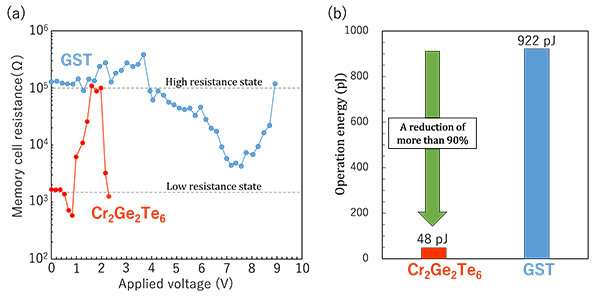Ultralow power consumption for data recording

A team of researchers at Tohoku University, in collaboration with the National Institute of Advanced Industrial Science and Technology (AIST) and Hanyang University, has developed new phase change material with electrical characteristics different from those of conventional materials. This new material allows a drastic reduction in power consumption for data recording in non-volatile random access memory.
Phase change random access memory (PCRAM) is a next-generation practical non-volatile memory. PCRAM is expected not only to replace flash memory, but also to be used for storage-class memory, which can mitigate the difference in latencies between DRAM and flash memory.
The principle of PCRAM operation relies on the change in electrical resistance between high-resistance amorphous states and low-resistance crystalline states in phase change material.
Ge-Sb-Te (GST) is a phase change material for PCRAM application. GST can operate at high speeds, but has poor data retention at high temperatures (~ 85 degrees C) and needs high power for data-recording.
This newly developed phase change material, Cr2Ge2Te6, exhibits an inverse resistance change from low-resistance amorphous states to high-resistance crystalline states. The researchers demonstrated that the Cr2Ge2Te6 can achieve a reduction of more than 90 percent in power consumption for data-recording compared to using conventional GST memory cell.
Simultaneously, Cr2Ge2Te6 was found to combine a faster operation speed (~30 ns) and a higher data retention property (over 170 degrees C) than conventional materials. Comparison with other reported materials indicates that Cr2Ge2Te6 can break the trade-off relationship between data retention and operation speed.
The researchers believe that the inverse resistance change Cr2Ge2Te6 is a breakthrough material for PCRAM with combined low operation energy, high data retention and fast operation speed.
More information: Shogo Hatayama et al, Inverse Resistance Change Cr2Ge2Te6-Based PCRAM Enabling Ultralow-Energy Amorphization, ACS Applied Materials & Interfaces (2017). DOI: 10.1021/acsami.7b16755
Journal information: ACS Applied Materials and Interfaces
Provided by Tohoku University



















